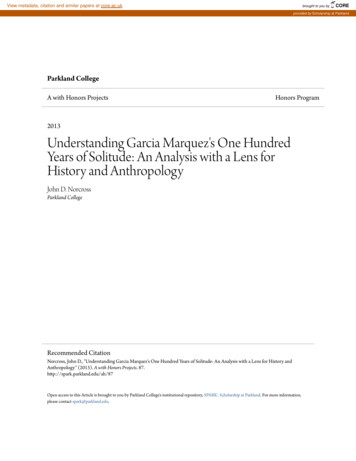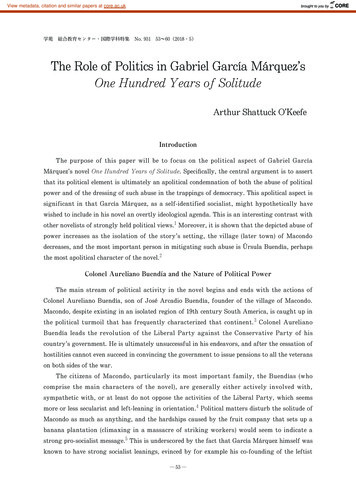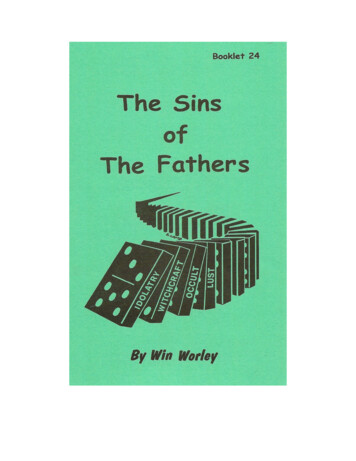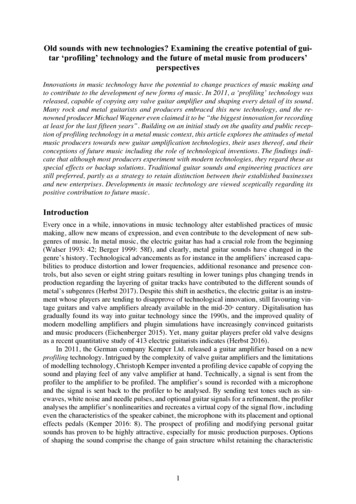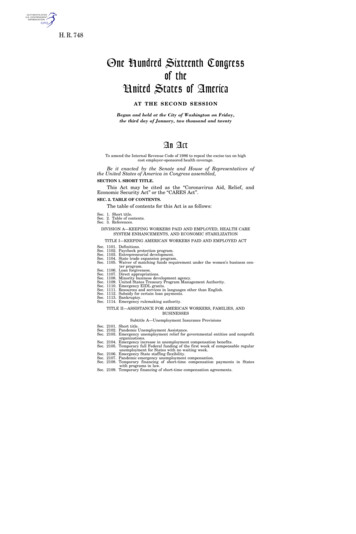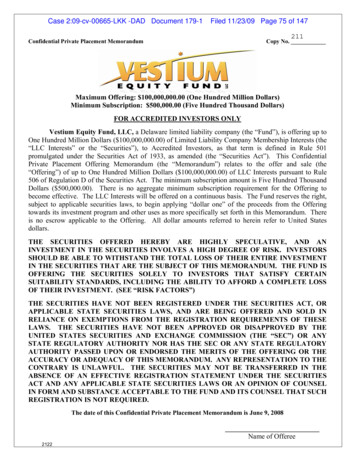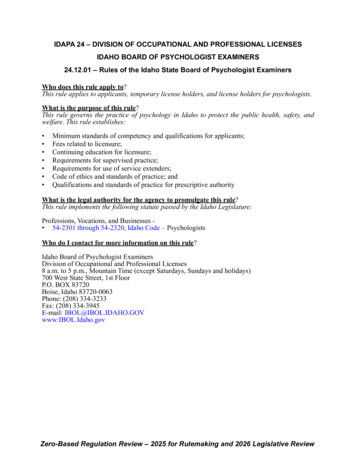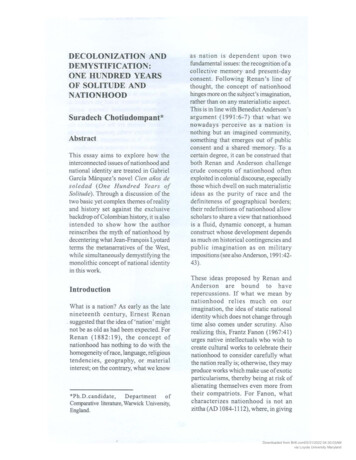
Transcription
DECOLONIZATION ANDDEMYSTIFICATION:ONE HUNDRED YEARSOF SOLITUDE ANDNATIONHOODSuradech Chotiudompant*AbstractThis essay aims to explore how theinterconnected issues of nationhood andnational identity are treated in GabrielGarcia Marquez's novel Cien aiios desoledad (One Hundred Years ofSolitude). Through a discussion of thetwo basic yet complex themes of realityand history set against the exclusivebackdrop of Colombian history, it is alsointended to show how the authorreinscribes the myth of nationhood bydecentering what Jean-Fran9ois Lyotardterms the metanarratives of the West,while simultaneously demystifying themonolithic concept of national identityin this work.IntroductionWhat is a nation? As early as the latenineteenth century, Ernest Renan. suggested that the idea of' nation' mightnot be as old as had been expected. ForRenan (I 882: 19), the concept ofnationhood has nothing to do with thehomogeneity of race, language, religioustendencies, geography, or materialinterest; on the contrary, what we know*Ph.D.candidate,DepartmentofComparative literature, Warwick University,England.as nation is dependent upon twofundamental issues: the recognition of acollective memory and present-dayconsent. Following Renan's line ofthought, the concept of nationhoodhinges more on the subject's imagination,rather than on any materialistic aspect.This is in line with Benedict Anderson'sargument (1991:6-7) that what wenowadays perceive as a nation isnothing but an imagined community,something that emerges out of publicconsent and a shared memory. To acertain degree, it can be construed thatboth Renan and Anderson challengecrude concepts of nationhood oftenexploited in colonial discourse, especiallythose which dwell on such materialisticideas as the purity of race and thedefiniteness of geographical borders;their redefinitions of nationhood allowscholars to share a view that nationhoodis a fluid, dynamic concept, a humanconstruct whose development dependsas much on historical contingencies andpublic imagination as on militaryimpositions (see also Anderson, 1991:4243).These ideas proposed by Renan andAnderson are bound to haverepercussions. If what we mean bynationhood relies much on ourimagination, the idea of static nationalidentity which does not change throughtime also comes under scrutiny. Alsorealizing this, Frantz Fanon (1967:41)urges native intellectuals who wish tocreate cultural works to celebrate theirnationhood to consider carefully whatthe nation really is; otherwise, they mayproduce works which make use of exoticparticularisms, thereby being at risk ofalienating themselves even more fromtheir compatriots. For Fanon, whatcharacterizes nationhood is not anzittha (AD 1084-1112), where, in givingDownloaded from Brill.com03/31/2022 04:30:03AMvia Loyola University Maryland
Deconization and demystificationobjective entity; awaiting the artist'susurpation:since Independence, that is, for theneocolonial period'. This essay aims tofurther explore these views toinvestigate how Garcia Marquez makessense of nationhood and national identityin the context of Latin American postindependence through a discussion ofthe two main issues of reali ty andhistory.That extremely obviousobjectivity which seems tocharacterize a people is infact only the inert, alreadyforsaken result of frequent,and not always very coherent,adaptations of a much morefundamental substance whichitself is continually renewed(Fanon, 1967:41).Colombia, Latin America, andMacon doIt is worthwhile at this stage to look backat the Latin America continent to seehow Colombia has emerged. To discussColombia by discarding the picture ofLatin America as a whole would be arash, if not erratic, decision, since acountry now labelled as La Republicade Colombia only formed itself in thelate nineteenth century. Like othercountries in Latin America, Colombiagained its post-colonial independence inthe early nineteenth century; yet, theirsense of collective nationhood has stillnot been properly formed. According toJean Franco (1989:205), this can beattributed to the rise of oligarchic controlin many Latin American countries afterSpanish domination:Like Renan and Anderson, Fanonacknowledges the dynamic concept ofnationhood, arguing that the concept ismore fluid than it seems. Fanon alsosuggests that what we know as the nationis also more 'international', givenmodern techniques of informationtransfer, which renders the worldsmaller. The traffics of cultural transfer,be they language or dress, play a part indialectically reorganizing the publicimagination and, consequently, theircultural manifestations, which in tumaffect the sense of nationhood (Fanon,1967:42). In other words, what Fanondefines as the nation is anything butmonolithic and stagnant.This essay aims to link these theoreticalpositions to Gabriel Garcia Marquez'sOne Hundred Years of Solitude in anattempt to show how the Colombianwriter explores the myth of nationhoodin his novel through the establishmentof the Buendia family in the imaginarytown of Macondo. Garcia Marquezhimself said in an interview that OneHundred Years of Solitude can be readas an account of Latin American history(Mendoza, 1983:73). Gerald Martin( 1987:97) also suggests that 'the storyof the Buendia family is obviously ametaphor for the history ofthe continentthe stabilization of the nationstate (often built on oldcolonialbureaucraticinfrastructures) occurred forthe most part without grassroots participation or any formof democratic and was oftenvehiculated by autocratic orpopulist/authoritarian regimes.In addition, its vague territorial aspectand political instabilities, resulting in itsambiguous spatial borders, complicateColombia's rapport with the Continent.69Downloaded from Brill.com03/31/2022 04:30:03AMvia Loyola University Maryland
MANUSYA: Journal of Humanities (Special Issue. No.5.2003)On the most general level, LatinAmerica was one of the last continentsto be discovered. Its plethora ofresources had continued to lure peoplefrom other continents for centuries.Brought to the awareness of theWestern world by ChristopherColumbus, the continent subsequentlyunderwent surges of European peoplewho came in search of fortune. Givensuch interventions, the earlier kingdomsestablished by the natives, such as theIncas and the Mayas, went throughchanges in their cultural and powerstructures. During the seventeenthcentury, certain towns in present-dayColombia, such as Bogota andCartagena, were already centres ofintercontinental commerce and culturaltransfer. In the eighteenth century, at thecusp of colonial domination, Colombiawas part of the Viceroyalty of NewGranada.governors as they tried to establish theirown local governments. After thecolonial period, La RepublicadeColombia, or Colombia as we know ittoday, was not materialised until 1886,as the area had experienced a largescale of political instability (see alsoRaymond Leslie Williams, 1991 :5-12).Born in the early twentieth century,Garcia Marquez experienced thepolitical turmoil that lasted until the timewhen he was writing One HundredYears of Solitude. These immediatepolitical uncertainties, more often thannot taking place owing to ideologicalclashes mainly inspired by strong yetconflicting senses of patriotism, naturallylead Garcia Marquez to contemplate theessence ofpost-colonial national identity.His novels can be analysed in terms ofthis reflection of national consciousness,since the novel and nationhood aredeeply related, as Timothy Brennan(1990:50) argues:The processes of colonization by theSpanish were carried out with relativeease, as the assimilation between thetwo cultures was not as difficult as couldbe expected. In fact, they sharedcomparable ideas of politicalsovereignty: both the Iberian and thenative Latin American kingdomsbelieved that leadership and its legitimacyhad a divine source, as exemplified inthe system of monarchy. Furthermore,·both societies were seigneurial: thepower structure existed in hierarchicallevels, with nobles heading their subjectsand owning large estates worked bytribute-paying peasants. Apart from that,the colonial domination was alsofacilitated by the mestizaje (injudiciouslytranslated as miscegenation) among thethree main races, i.e., the Spaniards, theIndians, and the Africans. Colonialpower, however, lasted until 1810, whenjuntas of local nobles expelled royalthe novel [. ] directed itselfto an 'open-ended present'.In its hands, 'tradition'becamewhat[Eric]Hobsbawm calls a ' useablepast', and the evocation ofdeep , sacred origins insteadof furtheringunquesti oning, ritualisticreaffirmations of a people[ . ]- becomes a contemporary,practical means of creating apeople.Following Brennan 's logic, analysing anovel, therefore, can be an ei)Iichingexperience in the sense that it can givea perceptive reader an insight into hownationhood is brought into existence anddeveloped. In this light, an analysis of70Downloaded from Brill.com03/31/2022 04:30:03AMvia Loyola University Maryland
Deconization and demystificationMacondo in One Hundred Years ofSolitude can be seen as an investigationinto, and an affirmation of, what, for theColombian writer, constitutes nationhoodand a sense of national consciousness.Macondo's growth and its constantcontacts with external sources ofinfluence can be seen in parallel to thehistory of Colombia itself.the translation by Gregory Rebassa in theEveryman's Library edition ( 1995).tragic when Jose Arcadio Buendia killsPrudencio Aguilar to defend his honour.Even though the killing is later legitimizedas a duel of honour, the ghost ofPrudencio Aguilar continues to haunthim. Thus, Jose Arcadio Buendia thinksthat it is time he and his wife left thetown and founded a new one, wherepeople can live free of their past. Toanalyse Macondo as a nation in this lightcan thus be compared to a j oumey backthrough time, to the time when a nationfirst comes to exist, develop, andencounter extraneous influence, bothbenign and malign, not unlike theemergence of Colombia which hasstarted with hope after a long period ofcolonization and has withstood years ofpost-colonial conflicts and violence.At the beginning of the novel whenMacondo is established, the foundingpeople are full of hope and optimism.They leave their original homeland witha view to founding a town by the sea.However, after months of failure theydecide to stop travelling and simplyestablish a new city in the middle ofnowhere:[. ]Jose Arcadio Buendia andhis men, with wives andchildren, animals and all kindsof domestic implements, hadcrossed the mountains insearch of an outlet to the sea,and after twenty-six monthsthey gave up the expeditionand founded Macondo, so theywould not have to go back. Itwas, therefore, a route that didnot interest him, for it couldlead only to the past (OHS,14). 1Even though in the novel GarciaMarquez does not touch directly uponColombia during the colonial period, itsconsequences are still clearlyperceiveable. For instance, the presenceof Spanish Catholicism is symbolized inthe character of Father Nicanor Reyna,whom Don Apolinar Mascote brings toMacondo to preside over the weddingbetween his daughter and ColonelAureliano Buendia. However, as thenarrative is set during the so-called Warof the Thousand Days during the tumof the twentieth century, the presenceof colonial culture is more like lingeringremnants, a bundle of traces that outstaytheir welcome. This is metaphoricallyperceptible in the figure of the priesthimself: 'His skin was sad, with thebones almost exposed, and he had apronounced round stomach and theexpression of an old angel [.]' (OHS,86). Another manifestation ofcolonialism can be seen in the figure ofFernanda del Carpio, the wife ofIn fact, the founding couple, JoseArcadio Buendia and Ursula Iguanin,are relatives and their marriage in theirhomeland is scandalized, as peoplebelieve that their offspring will be cursedand born with a pig's tai l. Thisunfortunate situation is rendered more1All textual references of One HundredYears of Solitude, henceforth OHS, are to71Downloaded from Brill.com03/31/2022 04:30:03AMvia Loyola University Maryland
MANUSYA: Journal of Humanities (Special Issue. No.5.2003)Aureliano Segundo, who comes from anold historic town, presumably Bogotaitself, where the domination of colonialculture has made itself strongly felt.According to the narrator:Even though the rest of the familymembers tolerate her idiosyncrasy, theydo not understand her. This is because,before Fernanda's arrival, Macondowas still a relatively new town, foundedby Jose Arcadio Buendia and UrsulaIguaran in an attempt to free themselvesfrom the constraints of the town wherethey had been living.Fernanda was a woman whowas lost in the world. She hadbeen born and raised in a citysix hundred miles away, agloomy city where on ghostlynights the coaches of theviceroys still rattled throughthe cobbled streets. Thirtytwo belfries tolled a dirge atsix in the afternoon. In themanor house, which waspaved with tomblike slabs, thesun was never seen ( OHS,207).In this aspect, what happens in Macondoor, to be exact, in the Buendia family, isa replaying of what happens at themacro-cosmic level: Macondo is amicrocosmos, in which various sourcesof interventions and forces all play theirroles in determining the course of thetown, not unlike the birth and evolutionof a nation like Colombia itself, especiallywhen taking into account colonial andneo-colonial impositions upon itsestablishment at large. This interplaybetween the microcosmic and themacrocosmic is also suggested by HomiK. Bhabha (1994: 11 ), who argues for:The symbols of the colonial period, suchas the coaches of the viceroys and thethirty-two belfries, still remain in the citywhere Fernanda comes from. It is a sadcity where people are subjected tooppressive tradition of colonial heritage.surprising that, whenIt is thus notFernanda arrives in Macondo, therelative ease and freedom from rulespester her. She needs to set down rulesand conform to them in her dailyactivities. When she is married andmoves to live in the Buendia house, shetries to impose regulations and protocolsin everyday routines. For instance:redrawing the domestic spaceas the space of thenormalizing, pastoralizing, andindividuating techniques ofmodem power and police: thepersonal-is-the political; theworld-in-the home.The Buendia family and their hometownMacondo become a stage wherebyGarcia Marquez directs the drama ofhis nation. The name Macondo itselfappears in Jose Arcadio Buendia 'sdream on the night that he and otherfounders decide to choose the locationof their town. A vivid image of a townlooms large in this dream:She put an end to the customof eating in the kitchen andwhenever anyone was hungry,and she imposed the obligationof doing it at regular hours atthe large table in the diningroom, covered with a linencloth and with si lvercandlesticks and table service(OHS, 213).Jose Arcadio Buendiadreamed that night that right72Downloaded from Brill.com03/31/2022 04:30:03AMvia Loyola University Maryland
Deconization and demystificationthere a noisy city with houseshaving mirror walls rose up.He asked what city it was andthey answered him with aname that he had never heard,that had no meaning at all, butthat had a supernatural echo:inhisdlB:m :M a:r:n:b OHS,28).supernatural as part of oureveryday life. [. ]The historyof the Caribbean is full ofmagic - a magic brought byblack slaves from Africa butalso by Swedish, Dutch andEnglish pirates who thoughtnothing of setting up an OperaHouse in New Orleans orfilling women's teeth withdiamonds. Nowhere in theworld do you find the racialmixture and the contrastswhich you find in theCaribbean. [. ]Not only is itthe world which taught me towrite, it's the only place whereI really feel at home(Mendoza, 1983: 55).The fact that the town he dreams ofconsists of houses with mirror walls issymbolically revealing, as it can beinterpreted that Macondo itself servesas a mirror, its emergence reflecting thatof the real nation of Colombia.Magical Realism: RealityRe-imaginedThis alternative sense of reality thatGarcia Marquez derives from hischildhood. it can be argued, play aninfluential role in the emergence ofmagical realism in One Hundred Yearsof Solitude.Colombia is aware of the cultural andracial mixture that makes up itsnationhood. The reality of the Spanishis not the only reality that the Colombiansknow. This is especially the case withGarcia Marquez. As he was born inAracataca, a small town near theCaribbean coast of Colombia, he hasperceived a wide range of culturalmanifestations, entirely different fromthe inland culture of Bogota (asevidenced in One Hundred Years ofSolitude in the aforementioneddistinctions between Macondo and thecity where Fernanda comes from). Thecoastal area has absorbed not only thedominant culture of the colonial Spanish,but also the alternative cultures of thenative Indians and the Afro-Caribbeans.It is in this space of culturalheterogeneity that Garcia Marquezlearns a distinct, hybrid reality. In aninterview, he claims:Macondo is marked by extraordinaryevents that cannot be explained by dintof rationalism. Father Nicanor Reynarises six inches above the ground afterdrinking a cup of hot chocolate ( OHS,87). The blood of Jose Arcadia'smurdered body finds its way from hishome back to the kitchen of theBuendia's house where his mother ispreparing food (OHS, 136). The rain ofyellow flowers takes place in Macondo,covering roofs and blocking doors, whenthe patriarch Jose Arcadia Buendia dies(OHS, 144). Remedios the Beauty risesinto the sky, along with Fernanda'sexpensive sheets (OHS, 238). Macondobecomes at once a real yet uncannytown, where fantastic events arenormalized. For Macondo's population,these fantastic events are banal andThe Caribbean taught me tolook at reality in a differenttoaccepttheway,73Downloaded from Brill.com03/31/2022 04:30:03AMvia Loyola University Maryland
MANUSYA : Journal ofHumanities (Special Issue. No. 5.2003)happen every day. However, normalevents, or at least 'normal' events in ourown view, are strange and fabulous forthem. They are, for instance, surprisedat the ice, magnets, and magnifyingglasses brought in by the gypsies. Thesecontradictions between our world andMacondo raise questions about truth andreality and how we define them. Thisdistinctive literary style is often labelledas 'magical realism' , since it blendswhat we perceive as the rational andthe magical together. In defining magicalrealism, Jean-Pierre Durix (1998:1 46)argues that:proves that reality is full of the mostextraordinary things.' In saying this,Garcia Marquez, whether he likes it ornot, commits himself to the argumentmade earlier by Alejo Carpentier, amajor Cuban novelist, that magicalrealism (or what Carpentier terms ' loreal maravilloso') should be used torepresent true Latin American reality.According to Carpentier (1967:88):Because of the virginity of theland, our upbringing, ourontology, the Faustianpresence of the Indian and theblack man, the revel a tionconstituted by its recentdiscovery, its fecund racialmixing [mestizaje], Americais far from using up its wealthofmythologies. After all, whatis the entire history ofAmerica if not a chronicle ofthe marvellous real?the magic realist aims at abasis of mimetic illusion whiledestroying it regularly with astrange treatment of time,space, characters, or whatmany people [. ] take as thebasic rules of the physicalworld. Magic realists usuallyhave a definite idea of theirsocial role and pose politicalproblems, which beset the(post-colonial) countrydescribed.The politics behind Carpentier 's use ofthe marvellous real is clear; his versionof magical realism should be used as adominant literary mode in LatinAmerican literature as it truly representsthe consciousness of the continent,which has long been subjected to thedomination of Europe, in this respectobjectified by its sense of rationalism.Not only does Durix define magicalrealism in terms of its literary style, healso claims that it is deeply politicized,carrying an ideological position ofdescribing the otherness of the postcolonial world.Even though Carpentier's idea ofmagical realism as a uniquerepresentation of the Latin Americanconsciousness and identity has foundmany supporters (see Flores, 1955 ;Maria-Elena Angulo, 1995), it should benoted that the idea that the real and themarvellous cohabiting on one narrativeplane does not occur only in LatinAmerica. In 'Marvellous Real inAmerica', Carpentier (1955 :82) admitsGarcia Marquez himself (Mendoza,1983 :35) seems to enjoy this politicizedview of magical realism, saying thatEuropean readers might not understandthe reality behind the magical elementsin his stories because 'their rationalismprevents them seeing that reality isn'tlimited to the price of tomatoes andeggs . Everyday life in Latin America74Downloaded from Brill.com03/31/2022 04:30:03AMvia Loyola University Maryland
Deconization and demystificationthat in Franz Kafka's works and earliertexts such as Don Quijote, thisreactionary literary concept was alreadyexploited. In another essay, 'Baroqueand the Marvellous Real', Carpentier( 1981: 103) does not deny the influenceof surrealism that lies behind his thinking,as both his 'lo real maravilloso' andsurrealism attempt to play down theboundaries between the rational and theirrational, the real and the fantasy.However, he argues that, while themarvellous in surrealism is premeditated,the counterpart in his 'lo realmaravilloso' is more spontaneous:Carpentier is politicized to the extent thatthey are somehow synonymous withLatin American literature during the'Boom' period/ with writers claimingthat the reality of Latin America isdifferent and needs an alternative wayto recapture it. In his Nobel address,Garcia Marquez (1982:209) himselfasserts that:To interpret our realitythrough schemas which arealien to us only has the effectof making us even moreunknown, even less free, evenmore solitary.the marvellous real that Idefend and that is our ownmarvellous real is encounteredin its raw state, latent andomnipresent, in all that is LatinAmerica. Here the strange iscommonplace, and alwayswas commonplace(Carpentier, 1981: 104).'Schemas which are alien to us' are ina sense analogous to the epistemologicalpatterns which European colonialists orpresent-day US neocolonialists haveused to comprehend Latin America,similarly distinguished in their firm basisof rationalism. Yet, for Garcia Marquez,it is useless to adopt such schemas inLatin America because it is a continentWhile Carpentier expresses his debts toKafka and surrealism in constructing hisconcept of 'lo real maravilloso', LuisLeal (1967:120) shows that the term'magical realism' was in fact originallycoined by a European art critic, FranzRoh, in his attempt to theorize postexpressionist German paintings. In usingthe word 'magical' to precede 'realism',Roh ( 1925: 16) wishes to indicate that'the mystery does not descend to therepresented world, but rather hides andpalpitates behind it.'full of wonders and marvels, thosethat cannot be explained by rationalism.If one follows this argument closely,magical realism then signals whatAmaryll Chanady (1995: 125-26) terms'the territorialization of the imaginary' ,2 According to JohnS.Brushwood ( 1987: 13),the ill-named 'Boom' period possibly beganin the early 1960s with the originalpublication of Julio Cortezar, Hopscotch( 1963), reaching its peak in Gan!a Murquez,One Hundred Years of Solitude ( 1967).Philip Swanson (1995:2) argues that the'Boom' is 'an exemplification of the senseof 'break with tradition' that has come to beassociated with the new novel.' In thissense, it is used to typify a kind of modemLatin American fiction that rejects thepremises and structures of conventionalrealismOne might argue at this stage that theroots of mystery as theorized by Rohand Carpentier are inherently different,but one should not be blind to the factthat the blurring of the rationaVirrationalborders is equally fostered by bothscholars. Yet, magical realism a Ia75Downloaded from Brill.com03/31/2022 04:30:03AMvia Loyola University Maryland
MANUSYA: Journal of Humanities (Special issue. No.5.2003)especially in 'its insistence on theexceptional nature of New Worldgeography and partly to the LatinAmerican strategies of identityconstruction that emphasize regionalspecificities.' In this light, one can seethat Garcia Marquez attempts to usemagical realism in his novel as a way torepresent the uniqueness of his ownnation (or, to the same effect, his owncontinent). However, it should also behighlighted that magical realism is not aliterary style native to Colombia, or toLatin America as a whole. It hastransferred from Europe to the LatinAmerican continent in a process of whatmight be called reverse colonization,whereby it is reappropriated and madeto bear on Latin America's geographicaland cultural specificities. If GarciaMarquez wishes to purport that magicalrealism is a poetic mode unique to hiscontinent, his claim is justified in thesense that it represents the LatinAmerican consciousness in terms of itshybridity, i.e., the fact that its origins arehighly multicultural and heterogeneous.Following this line of thought, theColombian author manages to find thesuitable identity ofhis post-colonial voice,while at the same time evincing that thisvoice is not at all monolithic, but alreadyhybridized, as is the coastal area wherehe was born.bloodshed known simply as LaViolencia ( 1948-1965). The significanceof political uncertainties can be seen inStephen Minta 's claim (1987:5) that'perhaps the single most importantaspect of Colombian history since thecountry gained independence fromSpain has been the nature and extent ofthe political violence it has experienced' .If the War of a Thousand Days causedan estimated 100,000 deaths (in acountry whose total population thenamounted to less than four million), LaViolencia led to the tragic demise ofroughly a quarter of a million people(see also Minta, 1987:6).It was after La Violencia that OneHundred Years of Solitude was firstpublished. Thus it would not be too farfetched to argue that the novel is, in part,steeped in immediate political concerns,as Garcia Marquez attempts to makesense of what his country hasexperienced. This inevitably leads to hiscomtemplation of the nationhood ofColombia after its independence fromSpanish domination. War and violencethen become an integral part of the novelas they function as an integral part ofthe history of his country. In otherwords,ifhistory plays an important partin constructing nationhood, war andviolence certainly become part andparcel of Colombian history, with whichthe author needs to reckon in hisreflections on nationhood. For him, warand violence seem to yield a disparateIn Search of Lost TimeLike other countries in Latin America,after its independence in 1810, the areaof what we now know as Colombia hadbeen subjected to a series of politicalconflicts as the Conservatives and theLiberals struggled for absolute power intheir never-ending tug of war. 3 Thisresulted in several civil wars, such asthe War of a Thousand Days (18991903) and another period of endless3The Conservatives wished to restoreColombia its 'Hellenic/Catholic Arcadia',with its policy to support Spanish traditionallegacy and Catholicism. The Liberals, on theother hand, sought to modernize thecountry which they considered as'backward' .76Downloaded from Brill.com03/31/2022 04:30:03AMvia Loyola University Maryland
Deconization and demystificationimpact in Colombia: if they tend tosignify a sense of progress in theWestern world, marking a demise ofoppressive regime and a recognition ofthe demand of the oppressed, itscounterparts in Colombia appear toconvey a sense of a vicious cycle, amanifestation of things coming back fullcircle and ready to start all over again.This view is supported by the endless,repetitious wars between theConservatives and the Liberals, whichlead to no absolute, clearly definedprogress. In One Hundred Years ofSolitude, these wars are also significantand become part of the historicalbackdrop against which the Buendiafamily and Macondo are set. It all beginswith the arrival of Don ApolinarMoscote, a magistrate appointed fromBogota to govern Macondo. As a unifiedembodiment of the Conservatives,representative of the current centralgovernment, he asks the locals to painttheir houses blue (i.e., the colour of theConservatives) to celebrate nationalindependence. It can thus be argued thatDon Apolinar Mascote brings nationalpolitics to the microcosmic scene ofMacondo, where, before his arrival, theboundaries between the Conservativesand the Liberals, or the connotations ofblue and red, had not been known.Colonel Aureliano Buendia, for instance,needs to ask Don Apolinar Mascote totell him the differences between the twoparties since for him the boundariesbetween the two are very vague ( OHS,100). Garcia Marquez then plays up thefuzzy borders between the two partiesthroughout the novel. While ColonelAur·eliano Buendia and his leftistsupporters roam various regions ofColombia, trying to revolve against theoppressive regime, he asks his nephewArcadia, who is also a champion ofLiberal causes, to impose order uponMacondo. However, in doing so,Arcadia ironically becomes a harsh,cruel ruler who is drunk with power. Atone point, he is tempted to give the orderto kill Don Apolinar Mascote, whosedaughter, Remedios Mascote, isArcadia's own aunt (OHS, 109). ColonelAureliano Buendia himself starts to feelthe blurred boundaries between theConservatives and the Liberals when heis captured and sent to Macondo to beexecuted. He perceives 'how the townhas aged. The leaves of the almond tresswere broken. The houses painted blue,then painted red, had ended up with anindefinable colouration' (OHS, 128).The fact that the houses end up with amixture ofblue and red paints attests tothe fact that perha
Macondo in One Hundred Years of Solitude can be seen as an investigation into, and an affirmation of, what, for the Colombian writer, constitutes nationhood and a sense of national consciousness. Macondo's growth and its constant contacts with external sources of influence can be seen in parallel to the history of Colombia itself.Author: Suradech Chotiudompant
